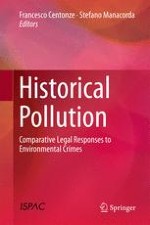2017 | OriginalPaper | Buchkapitel
7. Italian Administrative Regulation and Responsibility for Historical Pollution
verfasst von : Calogero Miccichè
Erschienen in: Historical Pollution
Aktivieren Sie unsere intelligente Suche, um passende Fachinhalte oder Patente zu finden.
Wählen Sie Textabschnitte aus um mit Künstlicher Intelligenz passenden Patente zu finden. powered by
Markieren Sie Textabschnitte, um KI-gestützt weitere passende Inhalte zu finden. powered by
